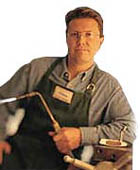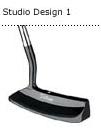product review
|
 |
| Scotty Cameron |
Now’s also a good time to try out a Cameron putter, because Titleist and Cameron introduced the new four-member Studio Design Putter Line earlier this year—blades milled from a solid block of soft carbon steel that not only performs admirably, they look impressive. Cameron commented: “I wanted the Studio Design line of putters to look as good as they feel. With feedback from the best players in the world, along with my own testing in the Studio, I have been able to create just that.”
The alloy used for the blade is very unique—I don’t recall seeing anything similar. It’s got a high-buff black oxide finish, which calls for special attention to keep the putter looking nice. The four members of the Studio Design Series all come with a new distinctive bright yellow/orange headcover with the new ‘Dancing Cameron’ logo, and a piece of soft felt-like cloth to wipe down the putter after every use. The soft carbon-steel is very sensitive to moisture, so the headcover and rubdown cloth will help keep the blade’s integrity over prolonged use.
The headcover also contains a slot for the patented Cameron Divot Repair tool, which is available as an accessory. It’s a utility piece designed to help golfers help the groundskeeper--in keeping their favorite greens rolling true, while putting their Scotty Camerons to the test.
After taking a good look at the Cameron Studio Design putter and pushing a few balls towards the hole on the Astroturf practice green in my favorite golf shop, it was time to try it out on the course. I could tell from first handling the putter it had a real nice balance to it. It seems like the putter’s weight is concentrated in the blade itself, which helps to swing it more like a pendulum. Better strokes equal better putts.
|
Chris McGinley, Titleist’s Vice President of Golf Club Marketing, echoed my impressions of the Studio Design Putter’s looks: “The Studio Design putters represent a return to Scotty’s roots as a designer, and gives Titleist a classically crafted line of blades.”
I hoped the classic putter would return my putting game to classic form. In this respect, it did not disappoint. After using it for four rounds and practicing all different types of putts on the practice green, I’d say it’s the softest putter I’ve ever used.
To me, softness in a putter equates to confidence in striking putts. When you’ve got a soft blade, you don’t feel a need to ‘baby’ putts. A soft putter and soft golf ball produce firm strokes and true putts. I’m not going to say this putter guaranteed everything from under 20 feet, but it certainly helped with short putts—and that’s where I’ve had a lot of trouble.
For one thing, it’s easier to line up ball and target. The design of the blade is the reason—McGinley says “The high-toe topline design helps insure proper alignment by eliminating the common desire to raise the toe of the blade at set up. Each Studio Design sole is carefully milled with slight negative bounce to insure the putter never sits closed. The new line also features a specially designed U-shaped, arch paddle grip, which helps to line things up visually.”
I also liked the fact there’s only a single dot on top of my Studio Design putter (model 1). It doesn’t get any easier—dot behind ball in a perpendicular line to the hole. Hit the putt firmly. Take the ball out of the cup. Now that’s breaking it down to the bare essentials.
 I will say I’ll need more time to get the proper speed down on putts, but the Cameron Studio Design putter takes away a lot of the alignment and ‘feel’ problems I was experiencing. I’d say right off, it helped me improve by a couple strokes—simply because I made more short putts than I normally would.
I will say I’ll need more time to get the proper speed down on putts, but the Cameron Studio Design putter takes away a lot of the alignment and ‘feel’ problems I was experiencing. I’d say right off, it helped me improve by a couple strokes—simply because I made more short putts than I normally would.
And I look forward to using it for a long time--maybe it’ll even help me become a proficient putter. If that’s the case, I’ll withdraw my petition to the USGA, asking it to base golf’s scoring values on the length of the shot—and maybe spare myself a little egg on the face in the process.
Titleist Scotty Cameron Studio Design Putters
Retail: $275.00 Divot Repair Tool: $9.95
Designed by Scotty Cameron
Available at Fine Pro Shops and Golf Retail Stores.
Check out more information about Scotty Cameron Putters at: http://www.titleist.com
Cameron Studio Design Page: http://www.titleist.com/htm/clubs/studio.asp
 Titleist’s Scotty Cameron Studio Design Putters
Titleist’s Scotty Cameron Studio Design Putters